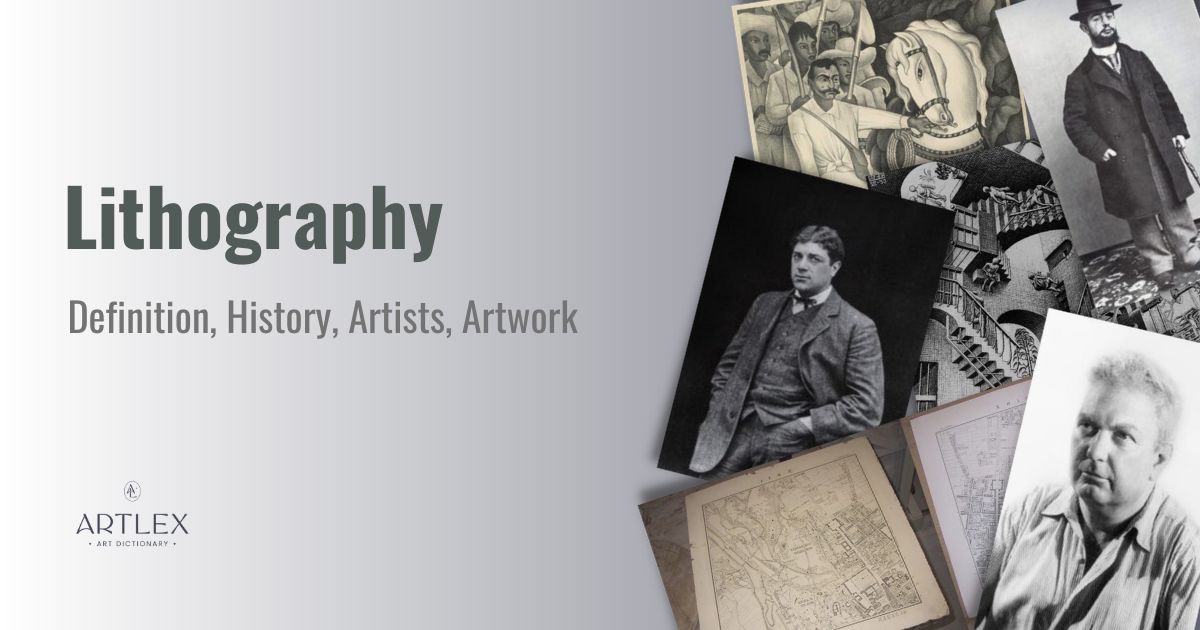
is a printmaking technique that uses stone slabs and oil-based grease crayons. Lithography was invented in Germany in 1798 by Aloy Senefelder, though the printing method did not gain popularity until the 1820s.
Lithography is a simple and inexpensive process, which has given it many uses throughout history, including in printing books, catalogs, and illustrations. Many notable artists have used it, including Georges Braque and Joan Miró.
Today, lithography is a popular printing method for many large-scale printers and artists.
What Is Lithography?
Lithography is a process where an artist draws an image on a flat surface (typically a prepared metal plate) that repels the ink. Because the surface doesn’t hold onto the ink well, it is easily transferred to paper or canvas, creating a sharp, high-quality print.
The word lithography comes from the Greek words for “stone” and “write,” which summarizes the lithographic process.
Lithography works by using oil-based ink on a water printing plate. Typically the image is first drawn with grease and water. Because the plate repels the printing ink, it is easy to transfer it onto the desired surface. Today, many printing processes use different lithography techniques to create an artist’s desired effect.
The History of Lithography
Since its invention in the eighteenth century, lithography has developed into a complex and precise process. These are some of the most significant developments in this printing process.
Invention of Lithography
Senefelder, a German writer, discovered lithography in 1798 when he used a grease crayon on a limestone slab.
He found that the ink on the limestone would leave an impression on a blank sheet and remain on the stone, allowing one drawing to be repeatedly replicated on the printing surface.
Over the next few years, Senefelder’s printing process gained traction in artist and printing circles. As lithographic printing knowledge spread, printers began to develop new techniques that allowed them to create various effects.
Color lithography developed in the second half of the nineteenth century. Artists would place colored ink on their slabs and then the sheet of paper, but only one color could be done at a time. Artists would stamp a piece of paper dozens of times to create their desired colors.
Photographic Lithography
Photographic lithography- also known as photolithography or optical lithography- is a form of lithography that utilizes light. It was invented in August of 1855 by French chemist Louis Poitevin.
While most lithography and printmaking techniques involve an artist drawing directly onto the stone or plate, photolithography instead uses a method that doesn’t involve traditional drawing at all.
In this type of lithography, a photographic image is transferred onto an aluminum plate using UV light and a chemical solution.
Dark parts of the photograph leave an oily surface on the aluminum, which will attract oil-based ink. The same sheet of aluminum can then be used many times to recreate the same image.
Introduction of Offset Lithography
Offset lithography was invented in England in 1875 by Robert Barclay. Barclay combined the lithography process with the process used for mass-produced word prints to create a new technique.
This lithography printing technique transfers prints from the printing plate to a rubber cylinder and then onto the printing surface, adding an extra step. The addition of the rubber surface step allows the printing plate to last longer than it would have otherwise.
Additionally, this rubber surface is often malleable and bendy so that patterns can be printed onto irregular, non-flat surfaces, such as helmets, plates, bowls, and other three-dimensional objects.
While offset lithography was an important new development for printing on irregular shapes and the longevity of prints, it was most important for the speed of printmaking.
Inking individual pieces one at a time took several minutes at least, not including time for setting up and drying. Offset printing takes only a few seconds per print and requires much less oversight from an expert.
Overall, offset printing made art printing far more accessible and inexpensive than anyone could have imagined was possible.
Revolution of Lithographic Plate
Traditionally, stone slabs were exclusively used for lithographic printing. But as technology developed, it became more common to use a metal plate instead.
These plates are typically composed of aluminum or zinc, though more often aluminum, and are more effective than stones because of their consistent structure.
Additionally, lithographic plates are much less expensive than large slabs of stone. This fact made the printing process far more accessible to other artists and art enthusiasts worldwide.
Types of Lithography in Art
As lithography has evolved, new techniques and printing processes have developed. Each lithographic process can create different effects and is used for different purposes. Here are five of the most prominent types of lithography used in the art world.
1. Stone Lithographs
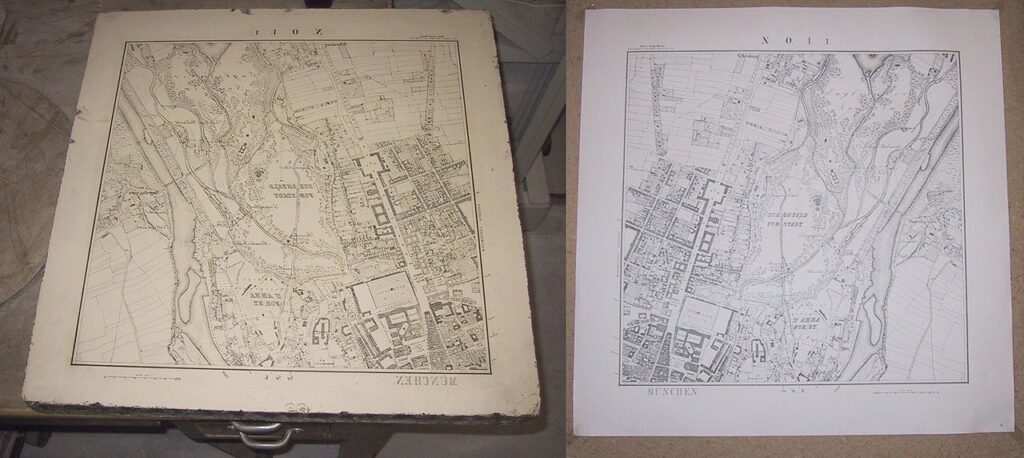
Stone lithography was the earliest form of lithography used. It was invented in the late eighteenth century by German author Aloy Senefelder and has been used by artists to create prints ever since.
Stone lithography uses a limestone slab, grease, ink, and the final canvas. In this process, an artist uses a greasy substance to draw their desired pattern onto a limestone slab. They then use a chemical process to make the design more permanent.
An artist can use a crafted lithography stone hundreds of times to print the same image over and over again repeatedly.
2. Plate Lithography
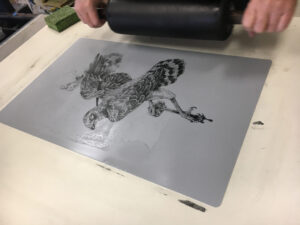
Plate lithographs were a significant development in the printing world. These metal plates have a much more consistent surface than traditional limestone plates, so it is possible to get a much more detailed printing using this process. Plate lithography often uses zinc or aluminum plates.
Aside from the metal plate instead of the limestone slab, plate lithography is very similar to stone lithography. The artist will still use grease- which attracts ink- to create their desired pattern. The artist will then lay paper onto the plate and make their final product.
3. Lithograph Reproductions
Lithographic reproduction is a process that can be used to recreate any art piece into a print. It uses photographic lithography to capture the desired image onto the lithographic plate. They will then use a color separation method to determine where specific ink colors will go.
An artist can use this information to create layers of color that will replicate the original art piece.
4. Mylar Plate Lithographs
Another critical development in lithographic art was the addition of mylar plates. The DuPont Company invented mylar in the 1950s. Mylar is a transparent or semi-transparent plastic material with many industrial and craft applications.
Mylar is an intermediary between the initial drawing and the plate creation in lithography. An artist can draw on a mylar plate or slab and then use a UV filter to transfer the image to an aluminum plate.
Mylar is beneficial because of its transparency. Artists can place mylar in front of a sketch or piece they want to lithograph and trace it, a method they cannot use when a pattern is drawn directly on aluminum plates.
5. Offset Print
Offset lithography is most commonly used in modern-day applications. This type of lithography is unique because it can transfer images onto any printing surface, even if it has an irregular shape.
Offset printing has one additional step compared to the traditional lithographic process. In this case, before the ink is transferred onto the final medium, it is transferred to a rubber surface.
Offset lithography occurs in four steps:
- Creating a roller: The pattern the manufacturer wants to print is created on an aluminum or zinc plate, as usual. However, instead of leaving this pattern flat, it is rolled up with the pattern facing outward.
- Ink is applied: The artist uses ink on the rolled metal plate.
- The second roller: The inked pattern will then roll against another roller made of rubber, transferring the ink but not the grease. This allows the initial design to last longer and prevents direct contact between the greasy substance and the paper.
- The final product is made: the rubber cylinder is then rolled over a sheet of paper, leaving the ink behind.
As sheets of paper pass underneath the cylinder, they will pick up whatever ink the cylinder contains. In many cases, a piece of paper will pass through many different cylinders containing many colors to create the ideal final result.
Artists and manufacturers can use a malleable rubber stamp instead of a roller to create a pattern on an irregular shape.
The Lithographic Process
The lithography process has become more complex in modern times, but many artists continue to use stone lithography to replicate their artworks. These are the steps to create stone lithographic artworks.
1. Prepare the Stone
The stone lithography process begins with preparing the limestone slab, referred to as a lithographic stone or litho stone for short. A single limestone slab may be used for years, and patterns can be sanded off to use the same stone for many printings.
The artist will use ‘graining’ to prepare the litho stone. To grain a limestone, the artist will use a levigator, water, and grit.
A levigator is a steel disk with a handle attached. The steel disk lays flat across the flat stone with the handle facing upwards. When the artist spins the handle, the steel disk will work with the grit to sand down the previous drawing.
The artist will use finer and finer grits along with the levigator to create a smooth surface that they can use for the next steps.
2. Draw on the Stone
After the stone is fully prepared, the artist may add their pattern or drawing. The artist will use a greasy substance to add their piece to the litho stone. This particular ink will repel water and attract ink.
An artist may use lithographic crayons, bars called rubbing blocks, or an ink called tusche to draw on the stone. Each material will absorb easily into the litho stone and act similarly after they are added.
In stone lithography, art is hand drawn. Because it is hand drawn, the artist can make mistakes while drafting their work. If the artist makes a mistake while drawing on the stone, they have a few options to fix the error.
First, an artist may erase a mistake by slightly sanding part of the stone back down or using a device such as a grease eraser.
If the mistake is too embedded for an eraser to work, the artist may also chemically remove the mistake. This process should be done carefully after protecting the parts of the drawing they want to keep with adhesive.
Chemical erasing may also result in unpredictable ink behavior. Artists must maintain caution when drawing over previously-erased sections of their stone.
3. Process the Stone
Once the artist is happy with their drawing, they can move on to the next step. Before ink can be applied to the piece, the artist must process the litho stone to ensure the best quality results.
First, the artist will apply two layers of powder to the litho stone- a rosin layer and a talc layer. These powders help absorb excess moisture before the next step.
The artist will then apply an etching solution to the stone. An etching solution is a mixture of gum arabic and nitric acid. Adding this mixture will create a hydrophilic (water-attracting) surface on the negative space (areas without grease).
After this is done, water is repelled by the drawing and attracted to the negative space. Conversely, the ink will be attracted to the drawing and repelled by the negative space. This process ensures that ink only does where the artist wants it to go.
4. Wash and Roll Up
Before the artist adds ink to the stone, they will first remove the original drawing. The chemical processes in the etching process will protect the pattern, so the grease pencil is no longer required.
To remove the drawing, the artist will add a solvent called lithotine. This solvent will help break down the unwanted grease pencil while leaving the hydrophilic gum arabic untouched.
This process will not remove the entirety of the original drawing and will leave a light impression behind, but it will remove enough of the grease for printing.
The last portion of preparing the stone involves the artist adding a layer of asphaltum. This material is rubbed into the stone to create an appropriate surface for the ink.
After the artist prepares the stone and lets it dry, they can add ink. The ink is oil-based, so it will naturally avoid the hydrophilic areas of the stone.
The artist will add water to the litho stone to ensure there is no ink in unwanted places. Doing so will push any remaining ink away from the unwanted areas.
5. Create Prints
After the artist has applied ink to the stone, they can begin making prints. The artist will lay a blank page across the image area. To ensure the ink fully saturates the page, the artist will place immense pressure on the page using a device like a pressure bar and a plexiglass sheet.
The plexiglass ensures that the bar’s pressure is even across the page.
Finally, the artist will remove the pressure bar and plexiglass, revealing a completed print of their drawing underneath. The ink must dry for several days before the artist can handle it regularly.
Lithographs vs. Offset Prints
Hand-made stone lithography and offset prints look similar, but if you’re trying to determine which kind you have, key features may clue you in.
-
- Signature: Artists will typically sign a hand-made stone lithograph. They will not sign offset prints or reproductions of their pieces. Whether an artist has signed a piece is one of the easiest ways to tell if you have an original work.
- Dots and Ink Patterns: Stone lithography and offset prints have different ink patterns on the page. For one, stone lithographs will have a raised surface where ink was applied, but offset prints will not. You may also look for dot patterns. If the ink appears to be small dots, it is likely a print, not a lithograph.
- Discoloration: Machine-made offset prints often have discoloration that indicates the machine was not kept clean.
Famous Lithograph Artists
Many artists, including Pablo Picasso, have used lithography to create copies of their art to distribute and share. These artists, however, worked in lithography, not just to make copies of their works made in other materials, but as their working medium.
Henri de Toulouse-Lautrec
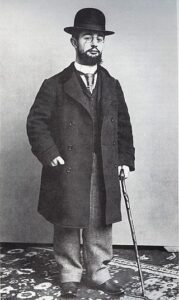
Henri de Toulouse-Lautrec is a post-impressionist painter, illustrator, and lithographer. He was born in 1901 in France.
Most art historians agree that Lautrec fell into art to cope with his severe disability. Lautrec broke both legs in his youth, and neither healed correctly due to a genetic disorder. Because of this, Lautrec had short, shield-length legs and a full-sized torso.
It is often suggested that Lautrec’s disability made him bolder and less cautious than other artists. He began working in lithography purely because it paid better, even though other artists looked down on it as ‘commercial.’
Lautrec’s lithographic posters for the French cabaret Moulin Rouge are undoubtedly his most famous works. As advertisements, they also paid better than most other projects, which is likely why Lautrec took them on.
Lautrec’s gamble to work in advertising paid off, as today, he is one of the most recognizable names in lithography. His works have sold for tens of millions of dollars, and he has been heralded as the father of modern-day graphic design.
Maurits Cornelis Escher
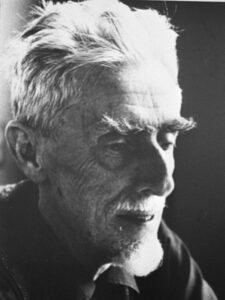
Maurits Cornelis Escher, more commonly referred to as M.C. Escher, is one of the most famous graphic designers of all time. He was born in Leeuwarden, a medium-sized city in the Netherlands, though he spent much of his life traveling Europe and living in Italy.
Escher took up lithography around 1930, in the middle of his career. Escher’s work was well suited to lithography, as he did not often use color, meaning he did not have to create multiple litho stones.
Though he became an avid user of stone lithography to create a series of his work, Escher never did the lithography himself. He would carefully and intricately design his litho stone and then leave the printing process to an expert.
After his death, Escher’s litho stones and printing press tools were damaged, as per his will. This clause in his will has made it easy for art fans to identify pieces created after his death and without his approval- all non-authorized lithographs have defects.
Joan Miró
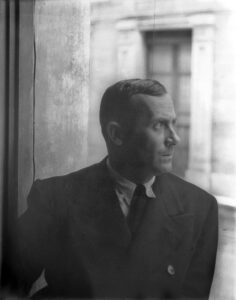
Joan Miró was a Spanish surrealist artist who is most famous for his oil paints, sculpture, and pencil work, but he also had a remarkable knack for cloth print mediums.
In print, Miró worked in intaglio (an inverted etching print technique), carborundum, and lithography. By the end of his career, Miró created more than 2,000 prints.
Miró’s style of art, which included many elaborate lines and swaths of color, lent itself well to printmaking of all kinds.
Miró also experimented with the printing press process itself. He would work closely with professional printmakers to alter and adjust his art pieces, producing new and unique ways of using lithography along the way.
Some of Miró’s more iconic print pieces were the illustrations he created for a book of poems by Tzara called L’arbre des Voyageurs. While the art was originally intended to be a companion to the book, the art was so thoughtful and well done that it became as integral to the poetry as the words themselves.
Alexander Calder
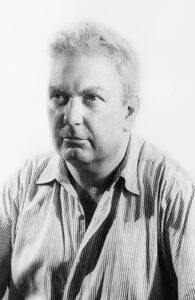
Alexander Calder was an American artist most known for his wire-hanging sculptures and kinetic art, but he was also a prolific printmaker.
Calder picked up printmaking around the middle of his career in the mid-1920s. He created illustrations for books, including the 1931 publishing of a book of fairytales.
As Calder moved towards more abstract art, his printmaking became more abstract as well. He made lithographs that included swirls, thick and thin lines, and broad planes of color. This style can be seen in his piece Music Maestro Please, n.d.
Decades later, while most artists tried to keep their work away from political issues, Calder set himself apart and created lithographic prints to protest the Vietnam War.
Georges Braque
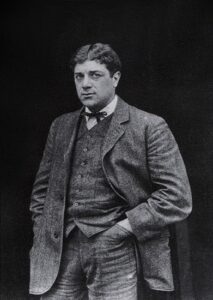
Georges Barque was a French artist who worked in painting, drawing, sculpting, and lithographic printmaking. Braque was a part of many art movements, including cubism, expressionism, fauvism, surrealism, modern art, and many others.
The subject of many of Braque’s prints were birds, landscapes, and other nature themes. Braque’s colored bird lithograph Deux Oiseaux (Richesse de la France), 1961, represents his nature-themed pieces.
You can see flat planes of bright color, like those in Deux Oiseaux, in many of Braque’s lithographs, including his non-printed works.
Examples of Lithographic Art
There have been many famous lithographic pieces in art history, some with offset printing and others using traditional Bavarian limestone slabs. Here are some of the most significant lithographic artworks in the world.
Boxers by Théodore Gericault, 1818
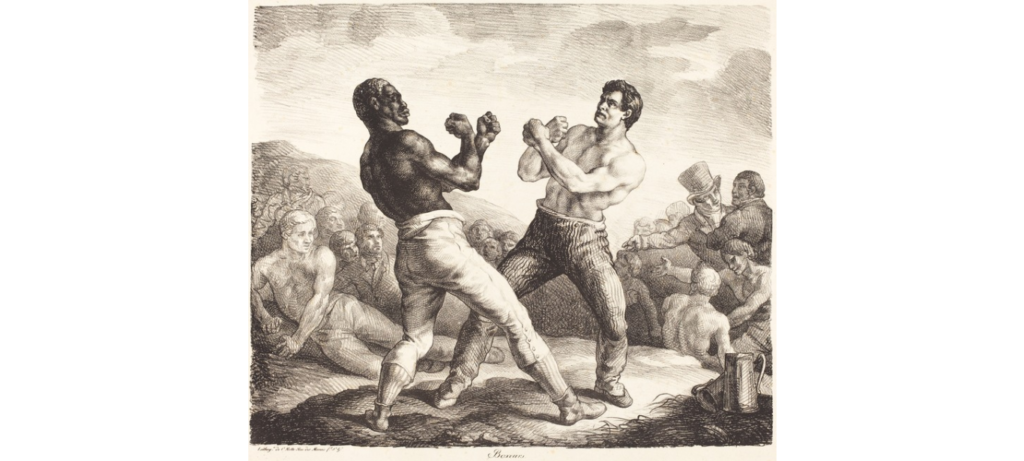
Théodore Gericault was a French painter and lithographer famous for many pieces that capture the drama and emotion of life. Boxers exemplifies Gericault’s skill in capturing these intense feelings.
The image depicted in Boxers is of two men with their fists raised, leaning away from each other and preparing to fight. The men are surrounded by an audience, who are, Baroque-Esq, engaged in their own, individual dramas.
Lithography was only beginning to take off when Gericault tried his hand at the medium. He crafted a few different lithographs depicting boxers and fights, but none took off as much as Boxers.
Boxers demonstrates how Gericault was at the very edge of art during his career. Most artists would not take to the lithography medium until the 1820s at the earliest, by which time Gericault had been making lithography for many years.
Moulin Rouge: La Goulue by Henri de Toulouse-Lautrec, 1891
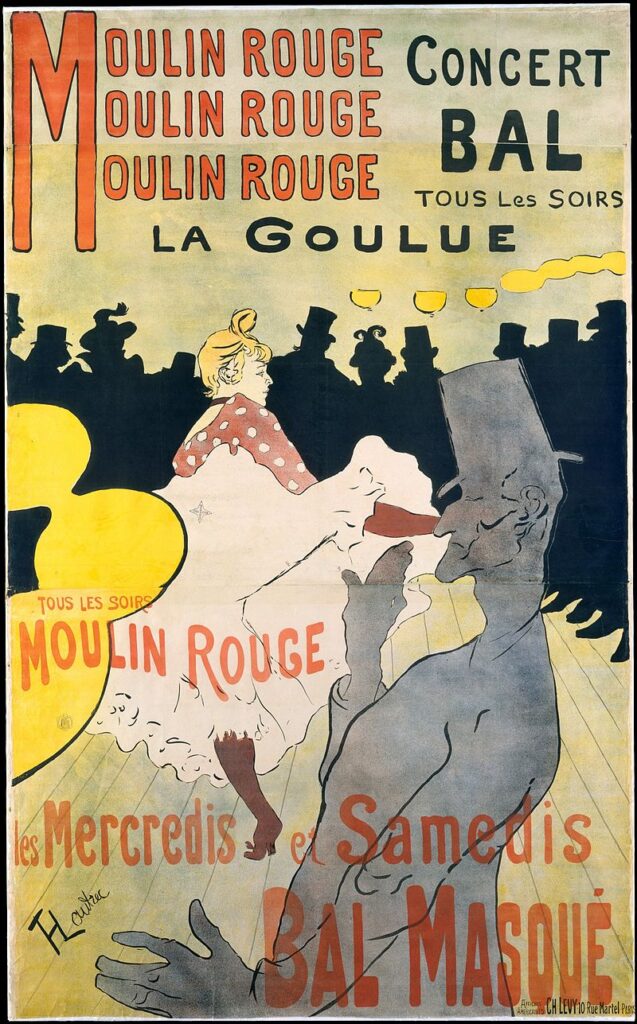
Moulin Rouge: La Goulue was Henri de Toulouse-Lautrec’s first lithographic poster (meaning it was made with an offset print style, not in traditional stone lithography). Lautrec made the sign as an advertisement for the opening of the Paris cabaret Moulin Rouge.
Moulin Rouge: La Goulue depicts a cancan dancer with her leg raised in a raunchy manner dancing the cancan to a group of onlookers. The simple design and sharp, broad colors made the poster eye-catching and easy to read.
Lautrec’s method of distributing Moulin Rouge posters was as much a reason for its fame as the art itself- though the suggestive content of the piece was a not-insignificant reason for the advertisement’s success.
Lautrec printed roughly 3,000 copies of the piece and plastered them around Paris. In a time when advertising posters with art were new, the method was incredibly effective.
The Races (Les Courses) by Édouard Manet, 1865-72
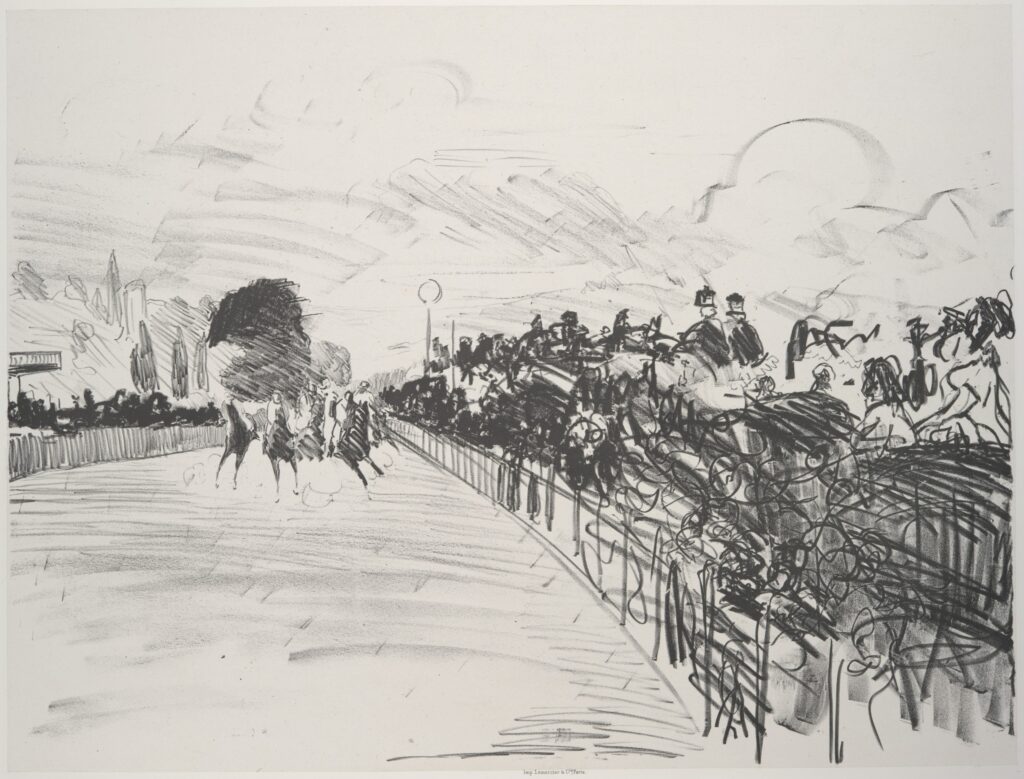
Horse racing was one of the most popular sports in the Second Empire of France. Manet captured many of these races in many mediums, creating a series of racing pieces he called Les Courses (The Races).
Les Courses broke new ground with their production. Previously, most depictions of the races captured a side view of the race and the placing of the horses. Works in Les Courses were different- they captured the horses from the front.
Les Courses does a remarkable job of capturing the crowd’s energy and the shading of the scene in the difficult technique of lithography. Despite almost exclusively using fast, chaotic lines, the lithograph captures the details of the moment, from the outlines of the jockeys to the buildings overlooking the scene.
Emiliano Zapata and His Horse by Diego Rivera, 1932
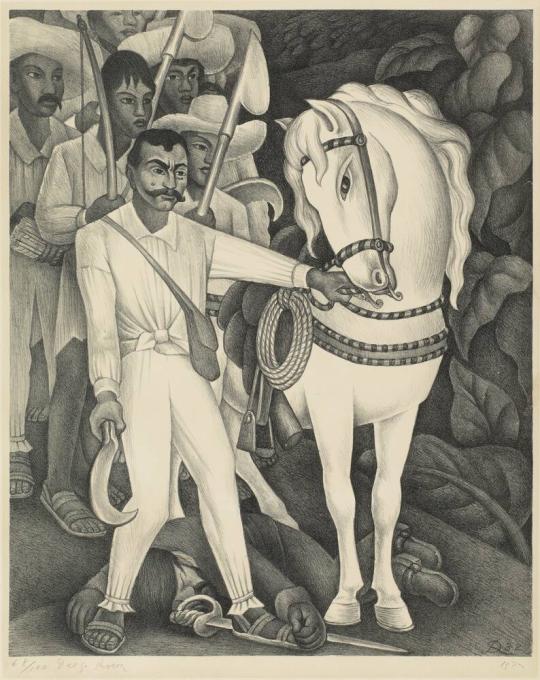
Diego Rivera’s piece Emiliano Zapata and His Horse, 1932, depicts Emiliano Zapata, one of the most prominent leaders of the Mexican Revolution, in the early 1900s. Next to him is a horse that belonged to the aristocrat lying dead at Zapata’s feet.
Rivera originally created the piece as a mural in a more extensive work depicting the history of Mexico at the Palace of Cortés in Cuernavaca.
When his work gained traction in the United States, he had it made as a lithograph in New York. The work’s lithographed version is the most commonly seen in galleries and the Metropolitan Museum.
Relativity by M.C. Escher, 1953
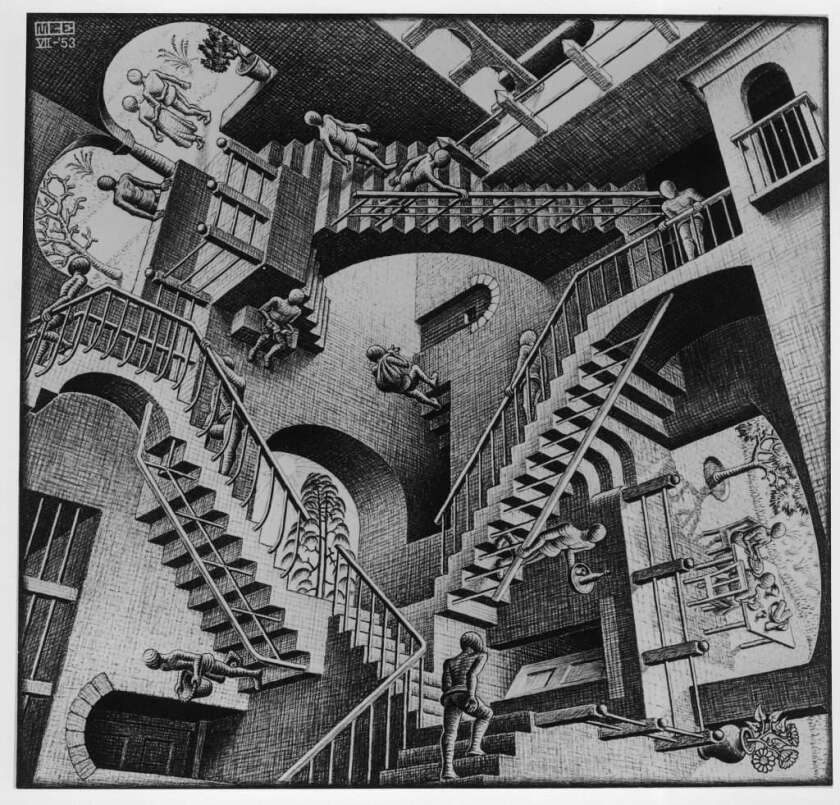
Escher’s works are most famous for their geometry and mathematics-inspired themes, and Relativity is no exception. Relativity is a black-and-white lithograph that features a carefully drawn impossible image. In it, there are staircases that lead to nowhere.
The piece is unique because it causes the viewer to look from one point to another, changing their perspective with each movement. It is intentionally confusing and disorienting with many different worlds that intersect.
The longer a viewer looks, the more apparent it becomes that the scene is not illogical, but rather that individuals in the piece are each affected differently by gravity- hence the name Relativity.
Relativity is referenced repeatedly in popular culture. Relativity (or references to it) appears in many movies, TV shows, songs, and video games.
FAQs
These are the most commonly asked questions about lithographic art.
Is lithography still used today?
Yes, lithography is still used today.
The process takes a while to set up, which makes it unreasonable for small batches, but it is a popular process for producing high-quality, sharply-colored, large-volume prints. Additionally, some modern artists continue to engage in stone lithography.
Why is it called lithography?
Lithography comes from the Greek “lithos,” meaning “stone,” and the Greek “graphein,” which means “to write.”
Final Thoughts
Lithography is a printing process based on oily ink and water that has evolved over the last few centuries into one of the most common printing techniques in the world. It is commonly used in commercial applications and the art world for its unique characteristics and scalability.
The invention of lithography had a significant impact on the art world. Its ability to create art images and patterns inexpensively transformed how art and decoration are seen in society.
From newspaper images to teenagers’ bedroom posters, lithography can be seen almost everywhere in modern-day life.
